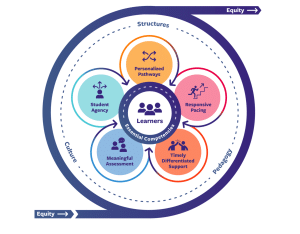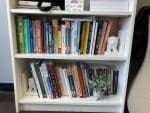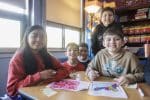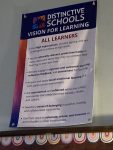Learners at the Center: Competency-Based Education at CICS West Belden
CompetencyWorks Blog
This is the third post in a series about CICS West Belden. In post 1, we introduced the school. In post 2, we focus on their community-centered approach. Check out the whole series!

Sitting around a table in a colorful office, the K-8 Chicago International Charter School (CICS) West Belden, managed by Distinctive Schools, students from grades 5-8 are excitedly comparing their classroom experiences. “Everybody’s at their own pace, but we’re learning the same thing. Our teacher, she doesn’t mind – she’ll be giving the lesson, and certain kids are already working on the assignment, or taking notes on what she’s saying, or have the same thing that she has on the board open on their computer but taking notes at their own pace. It’s more like independent work,” one seventh grader explains.
Another student agrees and shares another example. “In math we have a calendar of the lessons. So if we finish fast, we can go on to the next day and finish it early. And I’ve seen students get pulled into groups. Like, maybe they learn a little slower, so they can go at their own pace. So they still learn everything we’re learning, just in a different way, how they learn.”
Later, a fifth grade student describes the same dynamic. “In second grade I got more advanced than other students in math. So while everyone else was learning basic adding, I was already – not smarter, but a bit more advanced than others. So I said that to my teacher, and they helped me get harder things, like starting multiplication and stuff like that before anyone else…. It helped me get more entertained with math. It made me feel special. It’s good to know that there’s other people that can help you, no matter if you are higher than other people or lower than other people.”
The students’ eyes light up as they describe the way their teachers have helped them feel supported – sometimes because they needed to move faster to more advanced content, and other times because they needed to spend more time on the fundamentals. As an observer, it’s interesting to note the lack of shyness or social comparison as they discuss their learning. In this particular group of middle schoolers, there doesn’t seem to be any shame in needing more support in a certain area, nor any embarrassment about loving to learn and going deeper. Instead, there just seems to be delight as they describe their favorite projects, on topics as varied as Mahatma Gandhi, Albert Einstein, solar clocks, and pandas.
This personalized learning, defined as “tailoring learning for each student’s strengths, needs, and interests to provide flexibility and supports to ensure mastery of the highest standards possible” (Gross, Tuckman, & Patrick, 2018), is a core part of a competency-based approach to education. Competency-based education systems provide structures that increase the effectiveness of personalized learning, such as validation of proficiency based on student work, careful monitoring of pace and progress, and an intentional focus on equity to ensure all students reach the same high standards.
As we described in our opening post for this series, there are seven key elements that define competency-based education. These are:
- Essential competencies
- Equitable culture, structure, & pedagogy
- Student agency
- Meaningful assessment
- Responsive pacing
- Personalized pathways
- Timely differentiated support

In this post, we’ll explore the ways in which CICS West Belden enacts some of these seven key elements. We’ll celebrate the incredible work that they do to support and nurture their students, while also describing challenges they’ve faced and areas where they want to grow.
Essential Competencies
Rigorous, common expectations for learning (knowledge, skills, and dispositions) are explicit, transparent, measurable, and transferable. (Aurora Institute)
At CICS West Belden, students’ learning is still organized and measured by traditional course- and grade-level standards; the school does not yet have an explicit focus on transferable and cross-cutting competencies. However, they are moving in that direction. The Distinctive Schools network uses the LEAP Learning Framework, and Principal Eng is clear about the school’s current focus on the “learner focused” piece, which prioritizes knowing students deeply to build a foundation for the other pieces of the framework. She explains, “Here at West Belden, learner focused has been our strong suit. That has also been our focus for this year, because that’s where we get to know the child holistically. We know that students and children are not numbers. They are still little human beings that we are trying to mold to to be the best that they can be.”
Special education teacher Brian Finnerty agrees, and identifies community members as part of that work too: “Community engagement impacts our instructional practice because it just shows that everybody cares, right? They all have the same goal. They have the same outcomes. We want to create just good people. I think that is important with where our society is today – creating people that can go out and make an impact.” This overarching focus on students’ holistic development as people, regardless of the class or activity they are part of, is a good precursor to building out a more comprehensive set of competencies at the school in the years to come.
Equitable Culture, Structure, and Pedagogy
Strategies to ensure equity for all students are embedded in the culture, structure, and pedagogy of schools and education systems. (Aurora Institute)

Educational equity means that all children receive what they need to develop to their full academic and social potential. Embedding educational equity in the culture of a school requires “interrupting inequitable practices, examining biases, and creating inclusive multicultural school environments for adults and children; and discovering and cultivating the unique gifts, talents, and interests that every human possesses” (National Equity Project).
This is a big task, but CICS West Belden is intentional in their pursuit of this goal. As described in previous posts in this series, the school takes the work of creating an inclusive multicultural school environment seriously, and students feel like they are known and celebrated as whole people. The school provides linguistic supports to students and families who need them. As one seventh grader described, “There’s a couple people that only speak Spanish, so the teachers make sure that they’re still going at the same pace as everybody else, and are making sure they’re not feeling left out or not being separated from everybody else because they can’t understand what we’re saying.”
The school also takes the work of discovering and cultivating each individual student’s gifts and interests seriously, through work as varied as start-of-year interviews, in-person conferences, and referrals to clubs and activities outside of school. Overall, the school staff is clear about their belief that all students can learn and must be challenged, believed in, and supported to achieve deep learning and meet high expectations, and students feel that too. As one eighth grader admitted, “I always want to slack off, but you know, I gotta do it for my future. And… I can do this. Like, my teacher believes in me, my friends believe in me, my parents believe in me. I have a lot of people who could back me up.”

The school also has built structures that help address students’ and families’ differing needs. For example, the school has a “soft start” program that allows students to come to school early, get breakfast, and do something fun or relaxing (like play games in the gym) to ease into the day. This program has many benefits, including that it allows more flexibility for parents with early shifts to bring their child to school.
Of course, educational equity cannot be pursued in a vacuum; schools are still constrained by the larger context around them. Current concerns about ICE raids in the neighborhood and national anti-DEI policies have impacted students emotionally and depressed attendance at the school’s recent community events. But as Assistant Principal Kathy McInerney explained, the school is committed: “We’re not giving up on kids. We’re going to figure out what you guys need so that your family can be safe and your kids can be successful in school. We’re going to be here for you no matter what.”
Student Agency
Students are empowered daily to make important decisions about their learning experiences, how they will create and apply knowledge, and how they will demonstrate their learning. (Aurora Institute)

Students at CICS West Belden mentioned many small examples of ways their teachers empower them to make choices about their learning experiences. One seventh grader explained, “Before English class every day we read for 10 minutes. It could be a book of your choice, or if you don’t want to read, there’s always a writing prompt on the board where you can write about something – usually a question about yourself or how you feel about something.” Similarly, students mentioned projects where they got to choose the topic, or opportunities they had to choose different academic clubs or afterschool activities. All of these small things add up, building the muscle of student choice and voice.
In the classroom, student voice and choice also shows up in both big and small ways. Special education teacher Brian Finnerty explained one example of student choice in his classroom: “There are opportunities for students to say, ‘I would like to do a video, or I would like to draw something’… Some may not be comfortable speaking in front of the whole class yet. So we do give them those opportunities to choose a different path to show us what they have mastered, or where they’re at in their progress.”
Although each teacher decides how they implement student choice in their classrooms, Principal Eng explained one network-wide practice: empathy interviews. “At the very beginning of the school year we have individual conferences – empathy interviews – with every single student and family member. This really gives us insight to build relationships with their teacher for the year, but also to just understand what the family needs are, because then we can start right away with building resources for our families…. It also builds learner agency, where we’re really wanting the students to have a voice in what they’re learning and how they’re learning.”
Meaningful Assessment
Assessment is a meaningful, positive, and empowering learning experience for students that yields timely, relevant, and actionable evidence. (Aurora Institute)
Meaningful assessment practices, such as reassessment after additional learning and support, are clearly being implemented by many teachers. CICS West Belden’s assessment and grading policies prioritize equity, minimize bias, and provide multiple opportunities for students to demonstrate mastery. Using standards-referenced grading, teachers, families, and students receive a clear, evidence-based snapshot of progress toward rigorous grade-level goals. In designing assessments, teachers are guided by the school’s underlying belief in the ability of all students to learn and achieve at a high level, and a deep personal knowledge of each kid in their class.
Math teacher Angela Serrano explains how this shows up in her classroom: “It’s a math assessment, right? So when it’s the end of the unit, we take the assessment. But what I tell them is, it’s not the one ‘end-all be-all’, it’s an opportunity to show me that you do have the understanding. So they have a chance for a retake. And I tell them that with their first assessment, that’s where you are at that moment in time. And then if they want to come see me, if they have questions for me after the assessment, they can add it to their notes. They can ask me anything. We’ll go over it really quick, and they’ll be able to retake it later, using their notes, and also just showing me that they understand it at that next moment in time. That’s it, so they have more opportunities to show their growth.”
When a student retakes an assessment, she keeps whichever grade is higher. “Because for me, if on this date, you really understand it, great! You’re showing me that. If on that same date you are not understanding it yet, but a week later, you have studied and you showed me your growth, I’m not going to penalize you for not knowing it a week ago.” Ultimately, she says, it’s about giving students feedback and support so they can truly master the content.
Timely, Differentiated Support
Students receive timely, differentiated support based on their individual learning needs. (Aurora Institute)

In a typical CICS West Belden classroom, students are learning in all sorts of different ways. Students agreed that they could choose how they wanted to engage with the material in their classes. They keep track of what they’ve learned so far, and their teachers check in to make sure they’re on track and help them if they’re getting stuck. If they finish certain activities quickly, edtech tools like iReady and Epic help them go deeper into the material. “We don’t run out of work,” one student laughed.
The middle school uses block scheduling, which many teachers use to provide both whole-group instruction and small-group support for learners who need it. As Angela explains, “It’s an 80 minute block. So during the first 60 minutes, everyone is following the lesson. We do an exit ticket at the very end. Then the last 20 minutes is when I pull a small group based off of the exit ticket so they’re really able to master their learning – if they haven’t yet – in a smaller setting.” While students who need this small group or individual support work with the teacher, other students do revisions on their work, either independently or together, or work on other learning platforms. In this way, she is able to provide timely, differentiated support to different students and meet their individual learning needs, while still keeping the whole class on pace to reach high expectations of learning.
Responsive Pacing and Personalized Pathways
Students progress based on evidence of mastery, not seat time; students learn actively using different pathways and varied pacing. (Aurora Institute)
These two elements are interrelated: “In competency-based schools, student pathways are personalized, reflecting each student’s unique needs, strengths, interests, goals, and pace. The order in which students master learning targets both within and across academic disciplines may vary. Rather than coupling the standards with specific ages or grade levels, they are based on learning progressions that provide guidance to students within their zone of proximal development. Personalized learning experiences may include formal and informal learning opportunities both within and outside schools…. Varied pacing can mean that students who are proficient in certain standards are encouraged to engage in ways that lead to greater depth of knowledge and multiple ways of demonstrating competency. Varied pacing does not imply that there is a single learning pathway that students simply navigate at different speeds” (Levine & Patrick, 2019, p. 5).
Although these elements of competency-based learning are not currently present at CICS West Belden, glimmers of them are certainly visible in the school’s attention to student-centered learning, student choice, and differentiated support within the classroom. However, to fully implement these principles the school will need to build structures that enable even more flexibility and personalization – perhaps even harkening back to earlier initiatives like multi-grade classrooms (Source). As the school continues to build partnerships that support community-connected classroom instruction (see previous post), opportunities for students to learn in new ways and new places will continue to expand.
Conclusion
Although CICS West Belden is not yet a fully competency-based school, it is making progress in that direction, and the foundation is strong. Competency-based education requires “a deep redesign of the culture and structure of school systems to support effective instruction and learning” (p. 7) … to support every student in developing essential knowledge, skills, and dispositions. Foundational to that redesign is a commitment to students, and to designing a school’s culture and structure to support them as full people. As we have seen throughout this series, CICS West Belden’s clear commitment to students and their communities provides a perfect foundation for this ongoing work of school transformation. We can’t wait to see what the future holds for this school and its community!

This is the final post in a series of three posts about CICS West Belden. It is part of a larger series about schools that are implementing practices from both community-centered and competency-based educational systems in order to best serve their learners. We hope you’ll stick around for the rest of the series!
Learn More
- Welcome to West Belden
- CICS West Belden: For the Community
- Finding a Way Forward Together: Community Schools and CBE
 Kelly Organ joined the Aurora Institute as Research Manager in August 2024. She previously served as Director of Research Partnerships at a national nonprofit focused on youth well-being and social-emotional learning. Her career spans roles in service-learning, social entrepreneurship, action civics, and youth leadership programs, with a focus on developing culturally responsive and adaptable practices that support diverse learners.
Kelly Organ joined the Aurora Institute as Research Manager in August 2024. She previously served as Director of Research Partnerships at a national nonprofit focused on youth well-being and social-emotional learning. Her career spans roles in service-learning, social entrepreneurship, action civics, and youth leadership programs, with a focus on developing culturally responsive and adaptable practices that support diverse learners.